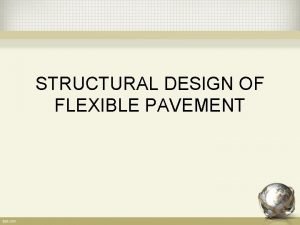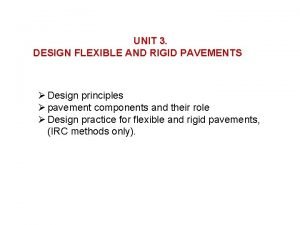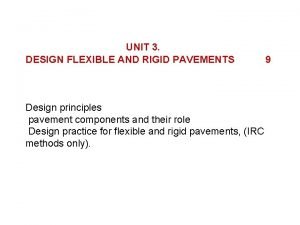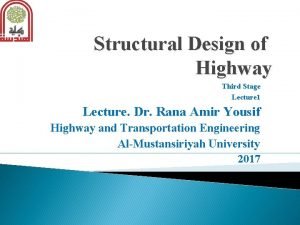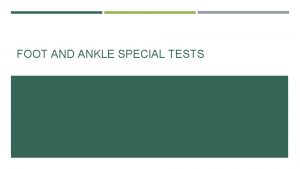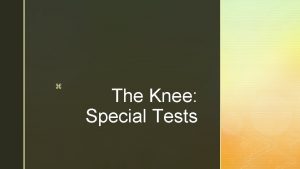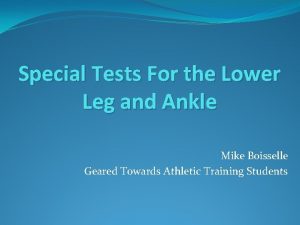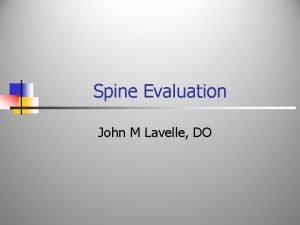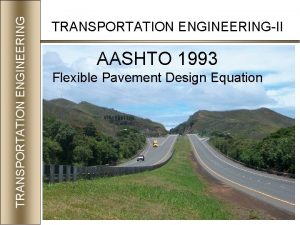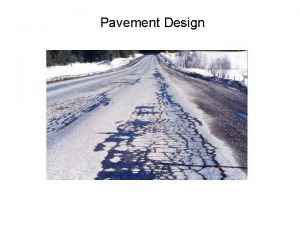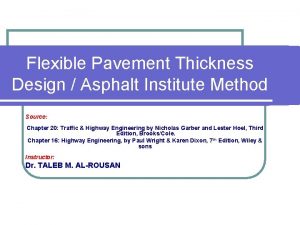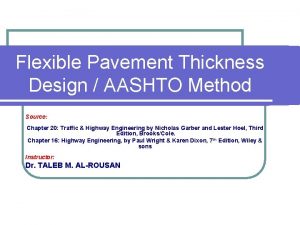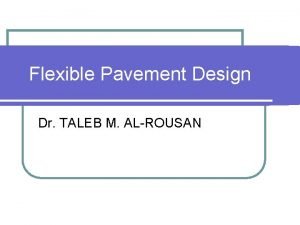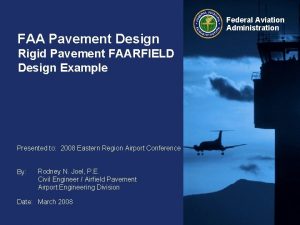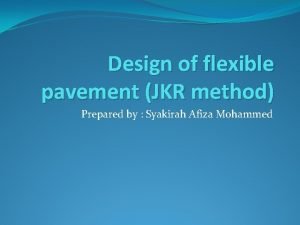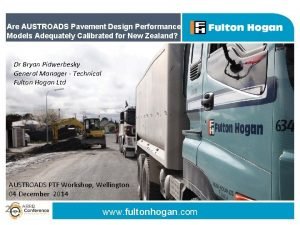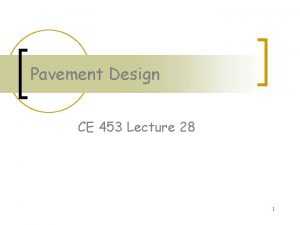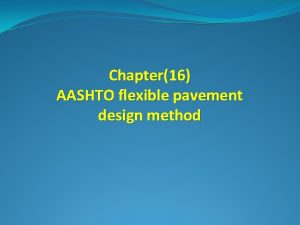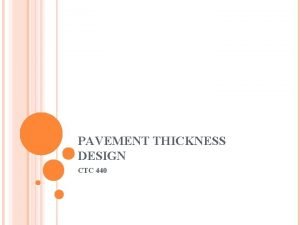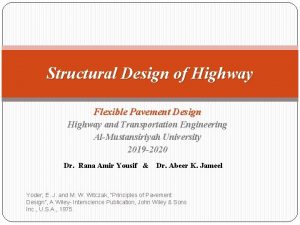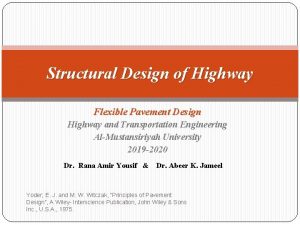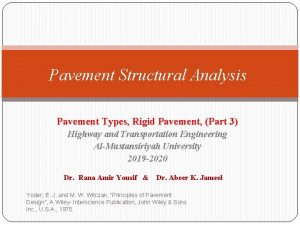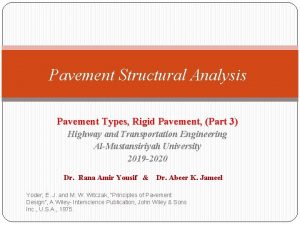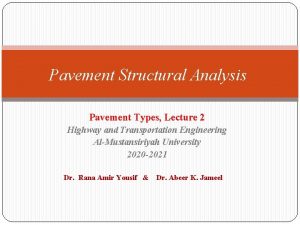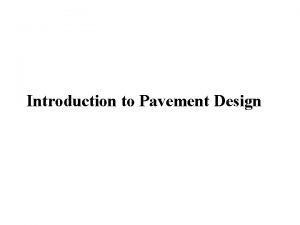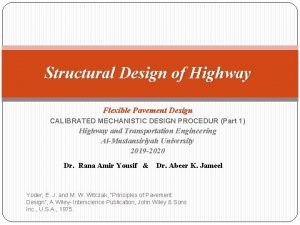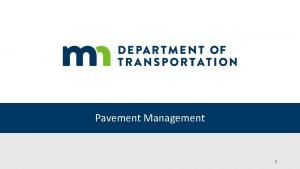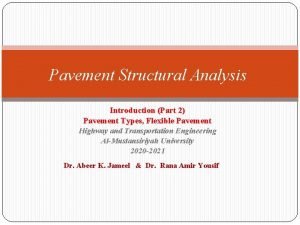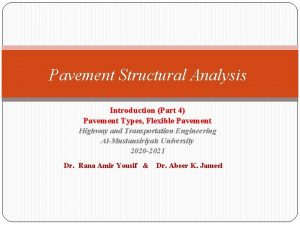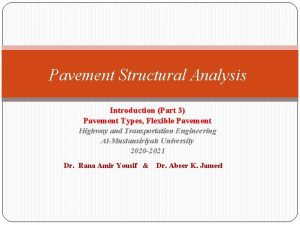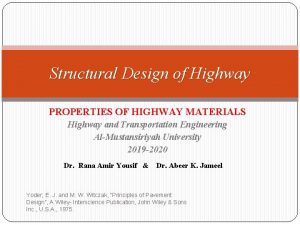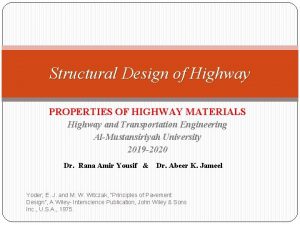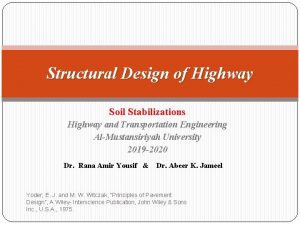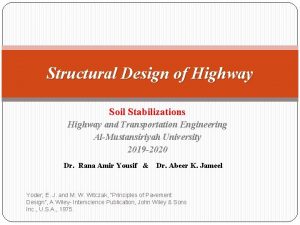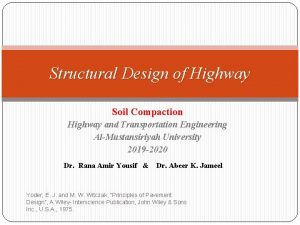Structural Design of Highway SPECIAL TESTS FOR PAVEMENT






















- Slides: 22

Structural Design of Highway SPECIAL TESTS FOR PAVEMENT DESIGN Highway and Transportation Engineering Al-Mustansiriyah University 2019 -2020 Dr. Rana Amir Yousif & Dr. Abeer K. Jameel Yoder; E. J. and M. W. Witczak, “Principles of Pavement Design”, A Wiley- Interscience Publication, John Wiley & Sons Inc. , U. S. A. , 1975.

References Ø Nicholas J. Garber and Lester A. Hoel. ”Traffic and Highway Engineering”, Fourth Edition. Ø Yoder; E. J. and M. W. Witczak, “Principles of Pavement Design”, A Wiley. Interscience Publication, John Wiley & Sons Inc. , U. S. A. , 1975. Ø Yaug H. Huang, “Pavement Analysis and Design”, Prentic Hall Inc. , U. S. A. , 1993. Ø “AASHTO Guide for Design of Pavement Structures 1993”, AASHTO, American Association of State Highway and Transportation Officials, U. S. A. , 1993. Ø Oglesby Clarkson H. , “Highway Engineering”, John Wiley & Sons Inc. , U. S. A. , 1975. Yoder; E. J. and M. W. Witczak, “Principles of Pavement Design”, A Wiley- Interscience Publication, John Wiley & Sons Inc. , U. S. A. , 1975.

Special Tests For Pavement Design 1 - California Bearing Ratio (CBR) Test This test is commonly known as the CBR test and involves the determination of the loaddeformation curve of the soil in the laboratory using the standard CBR testing The test is conducted on samples of soil compacted to required standards and immersed in water four days, during which time the samples are loaded with a surcharge that simulate the estimated weight of pavement material the soil will support. The objective of the test is to determine the relative strength of a soil with respect to crushed rock, which is considered an excellent coarse base material. This is obtained by conducting a penetration test on the samples still carrying the simulated load and using a standard CBR equipment. The CBR is defined as the penetration resistance of a sub-grade soil relative to a standard crushed rock. Yoder; E. J. and M. W. Witczak, “Principles of Pavement Design”, A Wiley- Interscience Publication, John Wiley & Sons Inc. , U. S. A. , 1975.

Special Tests For Pavement Design The unit load for 0. 1 piston in standard crushed rock is usually taken as 1000 lb/in 2, which gives the CBR as Load a piston (area = 3 in 2) at a constant rate (0. 05 in/min) Record Load every 0. 1 in penetration Total penetration not to exceed 0. 5 in. Draw Load-Penetration Curve. Yoder; E. J. and M. W. Witczak, “Principles of Pavement Design”, A Wiley- Interscience Publication, John Wiley & Sons Inc. , U. S. A. , 1975.

Special Tests For Pavement Design Yoder; E. J. and M. W. Witczak, “Principles of Pavement Design”, A Wiley- Interscience Publication, John Wiley & Sons Inc. , U. S. A. , 1975.

Special Tests For Pavement Design Yoder; E. J. and M. W. Witczak, “Principles of Pavement Design”, A Wiley- Interscience Publication, John Wiley & Sons Inc. , U. S. A. , 1975.

Special Tests For Pavement Design 2 - Resistance Value (R-Value) ASTM D 2844 : The Resistance Value (R-value) is a test value, which measures the ability of a soil to resist lateral flow due to vertically applied load. This test Developed by California Division of Highways in 1940 s, Measures frictional resistance of granular material to deformation. Uses the Hveem Stabilometer. Tests material in a saturated condition (worst case scenario) At the completion of the expansion test, the specimen is put into a flexible sleeve and placed in the stabilometer as shown in the figure. Vertical pressure is applied gradually on the specimen at a speed of 0. 05 in. /min until a pressure of 160 lb/in. 2 is attained. The corresponding horizontal pressure is immediately recorded. Yoder; E. J. and M. W. Witczak, “Principles of Pavement Design”, A Wiley- Interscience Publication, John Wiley & Sons Inc. , U. S. A. , 1975.

Special Tests For Pavement Design Yoder; E. J. and M. W. Witczak, “Principles of Pavement Design”, A Wiley- Interscience Publication, John Wiley & Sons Inc. , U. S. A. , 1975.

Correlations with Other Tests Various empirical tests have been used to determine the material properties for pavement design. Most of these tests measure the strength of the material and are not a true representation of the resilient modulus An extensive study was made by Van Til et al. (1972) to relate the resilient modulus and other test parameters to the soil support value or the layer coefficient employed in the AASHO design equation. These correlations can be used as a guide if other, more reliable, information is not available. It should be noted that any empirical correlation is based on a set of local conditions. The correlation is not valid if the actual conditions are different from those under which the correlation is established. Therefore, great care must be exercised in the judicious selection of the resilient modulus from these correlations. Yoder; E. J. and M. W. Witczak, “Principles of Pavement Design”, A Wiley- Interscience Publication, John Wiley & Sons Inc. , U. S. A. , 1975.

Subgrade Soils Figure 7. 10 shows a correlation chart that can be used to estimate the resilient modulus of subgrade soils from the R value, value CBR, CBR Texas triaxial classification, classification and group index. Correlations with Other Tests R value (C) R value (W) CB R As Example: If GI=2. 5 MR Draw horizontal line from GI=2. 5 Then we can get: MR=9000 CBR=9. 5 R value (W)= 38 R value ( C )=42 FIGURE 7. 10 Correlation chart for estimating resilient modulus of subgrade soils (1 psi = 6. 9 k. Pa ). (After Van Til et al. (1972). Yoder; E. J. and M. W. Witczak, “Principles of Pavement Design”, A Wiley- Interscience Publication, John Wiley & Sons Inc. , U. S. A. , 1975.

Correlations with Other Tests R Value: The R value is the resistance value of a soil determined by a stabilometer. The stabilometer test was developed by the California Division of Highway sand measures basically the internal friction of the material ; the cohesion for bonded materials is measured by the cohesiometer test. Figure 7. 11 is a schematic diagram of stabilometer, which is a closed-system triaxial test. A vertical pressure of 160 psi (1. 1 MPa) is applied to a sample, 4 in. (102 mm) in diameter and about 4. 5 in. (114 mm) in height, and the resulting horizontal pressures induced in the fluid within the rubber membrane are measured. Yoder; E. J. and M. W. Witczak, “Principles of Pavement Design”, A Wiley- Interscience Publication, John Wiley & Sons Inc. , U. S. A. , 1975. .

The resistance value is computed as: Correlations with Other Tests in which R is the resistance value ; pv is the applied vertical pressure of 160 psi (1. 1 MPa); ph is the transmitted horizontal pressure at p. S, of 160 psi (1. 1 MPa) ; and D 2 is the displacement of stabilometer fluid necessary to increase horizontal pressure from 5 to 100 psi (35 to 690 k. Pa), measured in revolutions of a calibrated pump handle. The value of D 2 is determined after the maximum vertical pressure of 160 psi (1. 1 MPa) is applied. If the sample is a liquid with no shear resistance, then ph = pv, or from Eq. 7. 5, R = 0. If the sample is rigid with no deformation at all, then ph = 0, or R = 100. Therefore, the R value ranges from 0 to 100. To ensure that the sample is saturated, California used an exudation pressure of 240 psi (1. 7 MPa), whereas Washington used 300 psi (2. 1 MPa). Yoder; E. J. and M. W. Witczak, “Principles of Pavement Design”, A Wiley- Interscience Publication, John Wiley & Sons Inc. , U. S. A. , 1975. .

Group Index: The group index, which ranges from 0 to 20, is used in the AASHTO soil classification system. The values vary with the percentage passing through a No. 200 sieve, the plasticity index, and the liquid limit and can be found from charts or formulas. Correlations with Other Tests In addition to Figure 7. 10, other correlations between MR, CBR, and R values are also available. These correlations could be quite different from those shown in Figure 7. 10 Heukelom and Klomp (1962) show that: -----(7. 6) in which MR is the resilient modulus in psi. The coefficient, 1500, could vary from 750 to 3000, with a factor of 2. Available data indicate that Eq. 7. 6 provides better results at values of CBR less than about 20. In other words, the correlation appears to be more reasonable for fine-grained soils and fine sands than for granular materials. Yoder; E. J. and M. W. Witczak, “Principles of Pavement Design”, A Wiley- Interscience Publication, John Wiley & Sons Inc. , U. S. A. , 1975.

The Asphalt Institute (1982) proposed the following correlation between MR and the R value : Laboratory data obtained from six different soil samples were used by the Asphalt Institute (1982) to illustrate the relationships, as shown in Table 7. 4. The R values were obtained at an exudation pressure of 240 psi (1. 7 MPa). The CBR samples were compacted at optimum moisture content to maximum density and soaked before testing. The repeated load triaxial tests were performed at optimum conditions using a deviator stress of 6 psi (41 k. Pa) and a confining pressure of 2 psi (14 k. Pa). Correlations with Other Tests -----(7. 7) It can be seen from Table 7. 4 that the equations for estimating MR from CBR and R values have a very limited range. The resilient moduli estimated from CBR values of 5. 2 and 7. 6 and R values of 18 and 21 generally conform to the guidelines for accuracy within a factor of 2. Estimates from CBR values of 25 or higher and R values above 60 would appear to overestimate MR by Eqs. 7. 6 and 7. 7. It should be noted that the MR of granular materials increases with the increase in confining pressure, and that of fine-grained soils decreases with the increase in deviator stress. Therefore, a large variety of correlations might be obtained, depending on the confining pressure or the deviator stress to be used in the resilient modulus test. Yoder; E. J. and M. W. Witczak, “Principles of Pavement Design”, A Wiley- Interscience Publication, John Wiley & Sons Inc. , U. S. A. , 1975.

Hot Mix Asphalt: Figure 7. 13 shows the relationships of the layer coefficient , Marshall stability, cohesiometer values, and resilient modulus Correlations with Other Tests The same procedur e for surface course As Example: for Base Course If Marshall Stability=1100 lb Draw horizontal line from M. S=1100 lb Then we can get: Yoder; E. J. and M. W. Witczak, “Principles of Pavement Design”, A Wiley- Interscience Publication, John Wiley & Sons Inc. , U. S. A. , 1975. Modulus =2. 25 Structural Coefficient (a 2)=0. 24

Structural Layer Coefficient In the AASHTO design method, the quality of the HMA, base, and subbase is indicated by their structural layer coefficients. These correlation charts were originally developed to determine the layer coefficients, but can also be used to determine the resilient modulus. More about layer coefficients is presented in Section 11. 3. 4. Yoder; E. J. and M. W. Witczak, “Principles of Pavement Design”, A Wiley- Interscience Publication, John Wiley & Sons Inc. , U. S. A. , 1975.

Example 7. 4: Given CBR values of 30 and 80, determine the corresponding R value, Texas classification, and resilient modulus when the materials are used as a base course, course a subbase course, course and a subgrade Correlations with Other Tests Solution: The correlations for base, subbase, and subgrade can be obtained from Figures 7. 15 a , 7. 16, and 7. 10. The results are tabulated in Table 7. 5. It can be seen from Table 7. 5 that the correlations among CBR, R value, and Texas classification are practically the same no matter whether the material is used as a base, a subbase, or a subgrade. This is not true for the resilient modulus, where a large variation exists. This is reasonable, because the resilient modulus depends on the state of stresses, which varies with the location where the material is to be placed. Yoder; E. J. and M. W. Witczak, “Principles of Pavement Design”, A Wiley- Interscience Publication, John Wiley & Sons Inc. , U. S. A. , 1975.

Correlations with Other Tests When CBR= 80 R value =83 Texas classification= 2. 1 resilient modulus=29000 When CBR= 30 R value =65 Texas classification= 3. 2 resilient modulus=20000 Yoder; E. J. and M. W. Witczak, “Principles of Pavement Design”, A Wiley- Interscience Publication, John Wiley & Sons Inc. , U. S. A. , 1975.

Correlations with Other Tests When CBR= 80 R value =85 Texas classification= 2. 3 resilient modulus=20000 When CBR= 30 R value =61 Texas classification= 3. 4 resilient modulus=14700 Yoder; E. J. and M. W. Witczak, “Principles of Pavement Design”, A Wiley- Interscience Publication, John Wiley & Sons Inc. , U. S. A. , 1975.

Correlations with Other Tests When CBR= 80 R value =83 Texas classification= 2. 1 resilient modulus=39000 When CBR= 30 R value =64 Texas classification= 3. 2 resilient modulus=19000 Yoder; E. J. and M. W. Witczak, “Principles of Pavement Design”, A Wiley- Interscience Publication, John Wiley & Sons Inc. , U. S. A. , 1975.

Correlations with Other Tests Yoder; E. J. and M. W. Witczak, “Principles of Pavement Design”, A Wiley- Interscience Publication, John Wiley & Sons Inc. , U. S. A. , 1975.

Structural Design of Highway THANKS FOR ATTENSION Dr. Rana Amir Yousif & Dr. Abeer K. Jameel Yoder; E. J. and M. W. Witczak, “Principles of Pavement Design”, A Wiley- Interscience Publication, John Wiley & Sons Inc. , U. S. A. , 1975.
 Asphalt pavement design example
Asphalt pavement design example Flexible pavement vs rigid pavement
Flexible pavement vs rigid pavement Flexible pavement vs rigid pavement
Flexible pavement vs rigid pavement What is rigid pavement
What is rigid pavement Ace different tests iq tests still
Ace different tests iq tests still Special test for ankle
Special test for ankle Apprehension test knee
Apprehension test knee Homen sign
Homen sign Stork test for spondylolisthesis
Stork test for spondylolisthesis Bone marrow hops 252
Bone marrow hops 252 Decorative design
Decorative design What is decorative design
What is decorative design Aashto structural number calculator
Aashto structural number calculator Cbr method of pavement design
Cbr method of pavement design Asphalt institute
Asphalt institute Aashto 1993 flexible pavement design example
Aashto 1993 flexible pavement design example Standard axle load for pavement design
Standard axle load for pavement design Cdfu meaning
Cdfu meaning Flexible pavement cross section
Flexible pavement cross section Austroads pavement design
Austroads pavement design Objectives of pavement design
Objectives of pavement design Aashto flexible pavement design example
Aashto flexible pavement design example Objectives of pavement design
Objectives of pavement design
